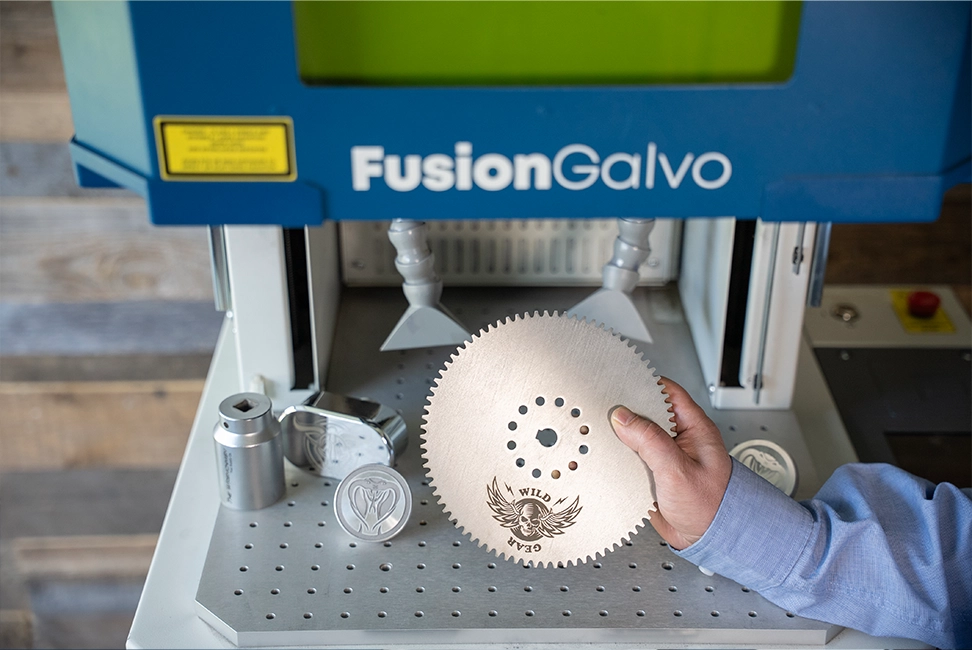Marcado de piezas automotrices con máquinas láser de fibra
La industria automotriz utiliza ampliamente láseres de fibra plana y láseres de fibra galvo para diversos procesos de fabricación. Los láseres de fibra se utilizan en la fabricación de automóviles para marcar permanentemente piezas y componentes con números de serie, logotipos, códigos de barras y mucho más. Pueden marcar y grabar en materiales metálicos y no metálicos, lo que los hace muy útiles para los fabricantes de automóviles.
Materiales compatibles
Los ingenieros diseñaron máquinas láser de fibra y galvo para marcar metales desnudos y una variedad de plásticos de ingeniería. Los materiales comunes marcados con una máquina láser de fibra y / o galvo incluyen:
- Metales: acero inoxidable, aluminio, cobre, latón, titanio, oro, plata, platino y más.
- Plásticos: Plásticos: ABS, policarbonato, acrílico, polietileno y más.
- Materiales de ingeniería: obleas de silicio, compuestos de carbono, etc.
Aplicaciones láser comunes en la industria automotriz
Los fabricantes utilizan láseres de fibra plana o galvo para marcar piezas de automóviles porque son precisos, rápidos y flexibles. Aquí hay algunas aplicaciones comunes que se pueden realizar en ambos tipos de láseres.
Números de serie y marcado VIN
Las piezas de automóviles pueden tener un número de serie único o VIN para el seguimiento y el control de calidad. El número de serie o VIN identifica cada pieza individual. Esto ayuda a garantizar que la pieza cumpla con los estándares de calidad. También ayuda a rastrear la pieza durante todo el proceso de fabricación.
Códigos de barras y códigos QR
El marcado láser de códigos de barras o códigos QR en piezas automotrices ayuda a rastrearlos automáticamente. También ayuda a gestionar el inventario y el control de calidad en la cadena de suministro
Marcado de cumplimiento
Las piezas de automóviles necesitan marcado para seguir reglas como el marcado CE, el cumplimiento de RoHS o las certificaciones de seguridad. Los láseres de fibra pueden marcar con precisión símbolos, logotipos o texto de cumplimiento en las piezas.
Medidas contra la falsificación
El marcado láser puede ayudar a prevenir productos falsos al agregar características de seguridad a las piezas de automóviles. Estas características pueden incluir texto pequeño, códigos secretos o marcas que muestran si alguien ha manipulado las piezas. Esto ayuda a disuadir la falsificación.
Identificación de piezas
Etiquetar las piezas con números ayuda a identificarlas durante el montaje, la reparación y el mantenimiento.
Logotipo y marca
Los láseres pueden agregar logotipos, nombres de marcas u otros elementos de marca a las piezas automotrices
Sellado de fecha y hora
Poner fechas en las piezas de automóviles ayuda a realizar un seguimiento del inventario y las garantías.
Texturizado de superficies con láser
La textura de la superficie con láser puede hacer que las piezas del automóvil, como las pastillas de freno, las placas de embrague y los engranajes, tengan menos fricción. Esto puede ayudarlos a desempeñarse mejor y durar más.
Trazabilidad de materiales
El marcado de materiales utilizados en piezas de automóviles, como la composición de la aleación o el grado del material, proporciona información crucial para los procesos de reciclaje, mantenimiento y reparación.
Ayudas de ensamblaje de componentes
El marcado láser puede ayudar a armar las piezas del automóvil al mostrar instrucciones, guías o marcas en las piezas. Esto facilita el montaje y reduce los errores.
La elección perfecta
Los sistemas láser de fibra plana y fibra galvo pueden marcar materiales de forma rápida y precisa para la fabricación de automóviles. Pueden marcar metales, plásticos, cerámicas y compuestos con precisión. Estas características los convierten en una solución ideal para diversas aplicaciones de marcado de piezas automotrices.
CLIENTE DESTACADO:
¿Qué tipos de marcas puedes lograr?
Grabe una variedad de marcas comunes de forma rápida y sencilla
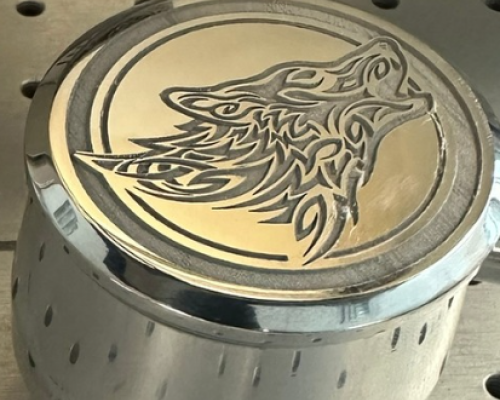
grabado
La gente suele utilizar el grabado con fines industriales para marcar herramientas o piezas con números de serie, logotipos y códigos de barras. El proceso de grabado elimina el material del metal. Se quita material para hacer una marca como un código de barras o un código de matriz de datos. Esto crea una marca clara en el metal a través de un grabado poco profundo.
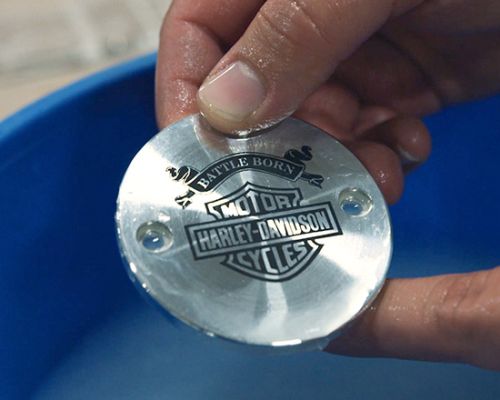
templado
Una marca recocida es como el proceso de pulido. El láser calienta el metal hasta casi puntos de fusión, lo que provoca un cambio de color en la capa superior del material. Dependiendo del tipo de metal, el recocido a menudo da un aspecto oscuro, casi iridiscente. Del mismo modo, puede usar la configuración de parámetros de fibra y galvo para producir colores distintos a propósito en ciertos materiales.
Dado que no se elimina ningún material del metal, esta técnica se usa a menudo para dispositivos médicos utilizados dentro del cuerpo humano. El recocido crea una marca oscura sin cortes ni grabados superficiales, a diferencia del marcado y el grabado.

pulido
Un rayo láser calienta la superficie del material para crear metal pulido, también conocido como "espejado". Luego, la superficie se enfría, lo que da como resultado un acabado brillante. Más común en el metal con acabado mate, esta técnica crea marcas que pueden parecer casi holográficas.
A diferencia del grabado, el calor altera el acabado del metal sin eliminar ningún material. El aspecto pulido se encuentra comúnmente en letreros elegantes y etiquetas de productos de alta calidad. Se utiliza para darles un aspecto sofisticado y único. El acabado espejado crea un aspecto tono sobre tono al marcar el metal.
La gente también usa esta técnica en óxido negro o metales con recubrimiento oscuro similar. Puede aclarar el recubrimiento de óxido/negro ajustando la configuración. Esto revela el color del metal debajo. El resultado es una apariencia contrastante tono sobre tono.
Metales comunes para marcar con máquinas Epilog Laser Fiber o Galvo
Aluminio anodizado
El grabado láser de aluminio anodizado con una máquina Epilog Laser es una excelente manera de crear marcas claras y duraderas en el metal. El anodizado agrega una capa protectora de color al aluminio, y el láser elimina esta capa para mostrar el metal más claro debajo. Esto crea un fuerte contraste que se destaca bien.
Las marcas grabadas son permanentes y resistentes al desgaste, la intemperie y los productos químicos. Esto hace que el proceso sea ideal para agregar logotipos, números de serial, códigos de barras o diseños a cosas como electrónica, herramientas y letreros. Tanto los láseres de CO2 como los de fibra pueden marcar aluminio anodizado de manera muy eficiente y con alta precisión, lo que los convierte en opciones ideales para marcar superficies metálicas.
Acero inoxidable
El marcado de acero inoxidable con máquinas de fibra o galvo de Epilog ofrece beneficios significativos en toda la industria automotriz.
Cuando se marca con una máquina láser basada en fibra o galvo, los usuarios pueden esperar marcas permanentes y duraderas en piezas y componentes de acero inoxidable. Estas marcas láser son resistentes al desgaste, los productos químicos, el calor y la corrosión, lo que las hace ideales para entornos hostiles y trazabilidad crítica.
Las máquinas láser de fibra y galvo marcan el acero inoxidable con una precisión y un detalle increíblemente altos, lo que garantiza que los códigos de barras y los códigos QR también se puedan escanear fácilmente para fines de seguimiento y rastreo.
Titanio
El marcado láser de titanio con una máquina Epilog ofrece varios beneficios críticos, especialmente para la fabricación de autopartes de alto rendimiento, donde tanto el rendimiento como el cumplimiento son importantes.
El titanio forma naturalmente una capa protectora de óxido, y el marcado láser (especialmente el recocido) lo mejora. En este tipo de metal, los láseres de fibra o galvo producen marcas químicamente estables, biocompatibles y resistentes a la abrasión.
¿Cuáles son las diferencias entre las máquinas láser de fibra plana y láser de fibra galvo?
Los láseres de fibra plana y los láseres galvo son dos tipos de sistemas láser utilizados para diferentes aplicaciones. Tienen diferencias únicas en su diseño, capacidades y usos adecuados.
Sistema láser: |
Cama plana |
FUSION GALVO |
Diseño: |
|
|
Velocidad / Precisión: |
|
|
¿Por qué el marcado láser es mejor que el marcado por micropercusión?
-
Alta precisión
El marcado láser es preciso y perfecto para crear diseños detallados, texto pequeño y gráficos sin distorsión. El marcado por micropercusión, aunque preciso, puede tener limitaciones para lograr detalles finos, especialmente en superficies curvas o irregulares.
-
Proceso sin contacto
El marcado láser es un proceso sin contacto, lo que significa que la herramienta de marcado no toca la pieza de trabajo. Esto reduce el riesgo de dañar las piezas delicadas y disminuye la posibilidad de errores. El marcado por micropercusión implica tocar la superficie directamente.
-
Versatilidad
Pueden marcar muchos materiales diferentes, como metales, plásticos, cerámicas, compuestos y más. Estos sistemas no requieren muchos cambios de configuración. El marcado por micropercusión puede requerir ajustes para diferentes materiales o acabados. Por otro lado, el marcado láser ofrece más flexibilidad y puede adaptarse a diversas necesidades de fabricación.
-
Velocidad y eficiencia
El marcado láser es más rápido que el marcado por micropercusión, especialmente para diseños intrincados o grandes lotes de piezas, lo que aumenta la velocidad. Los sistemas láser pueden alcanzar altas velocidades de marcado mientras mantienen una calidad y precisión constantes, lo que resulta en un mayor rendimiento y productividad en los procesos de fabricación automotriz.
-
Calidad y estética
El marcado láser crea marcas atractivas con bordes suaves y contraste, lo que hace que las piezas marcadas se vean mejor y más valiosas. El marcado por micropercusión, aunque duradero, puede producir marcas con bordes más ásperos y una apariencia menos uniforme, particularmente en ciertos materiales.
-
Sin consumibles
El marcado láser no necesita consumibles como brocas de grabado o cartuchos de tinta. Esto significa menores costos y menos mantenimiento en comparación con el marcado por micropercusión, que necesita el reemplazo regular de los pasadores de marcado.
Cómo:
Elegir entre un láser de fibra de cama plana y una máquina láser galvo
Decidir entre un láser de fibra plana y un láser galvo depende de varios factores. Estos factores incluyen las necesidades de su aplicación, el presupuesto, el volumen de producción y las capacidades deseadas.
Considere los siguientes puntos al tomar su decisión.
- Piense en qué materiales utilizará y qué tareas necesita que realice el sistema láser. Las empresas utilizan los láseres Galvo para marcar y grabar objetos pequeños o curvos debido a su rápido escaneo y control preciso. Los láseres de fibra de cama plana son buenos para marcar artículos grandes o numerosas piezas pequeñas idénticas.
- Los láseres Galvo son más rápidos que los láseres de fibra plana para marcar y grabar, especialmente en objetos pequeños o intrincados. Si la velocidad y el rendimiento son críticos para su aplicación, un láser galvo podría ser la mejor opción.
- Los láseres Galvo son excelentes para trabajos precisos y exactos, perfectos para tareas que necesitan detalles finos o diseños intrincados. Los láseres de fibra de cama plana también pueden ofrecer alta precisión, pero son más lentos que los sistemas galvo.
- Piense en el tamaño de su espacio de trabajo y sus limitaciones presupuestarias. Los sistemas láser Galvo tienen un espacio de trabajo más pequeño, pero pueden ser menos costosos que las máquinas planas. Los láseres de fibra plana tienen un espacio de trabajo mucho más grande, pero pueden ser más costosos al principio.
- Considere sus necesidades futuras y si el sistema láser elegido puede adaptarse al crecimiento potencial y la expansión de su negocio. Elija un sistema que ofrezca escalabilidad y flexibilidad para adaptarse a las demandas cambiantes y las nuevas aplicaciones.
Considere sus necesidades, presupuesto y objetivos futuros al decidir entre un láser de fibra de superficie plana y un láser galvo. Piense en las tareas específicas para las que necesita el láser y cómo cada tipo de láser puede satisfacer esas necesidades. Evalúe sus recursos financieros y determine cuánto puede permitirse invertir en una máquina láser.
Por último, considere sus objetivos comerciales a largo plazo y cómo el láser elegido lo ayudará a lograrlos. Cada tipo de láser tiene sus propias ventajas y desventajas que pueden afectar su decisión.
Debe basar su decisión en última instancia en lo que mejor respaldará el crecimiento y el éxito de su negocio en el futuro. Es importante considerar cuidadosamente estos factores y tal vez hablar con expertos o proveedores antes de tomar una decisión.
¿Y ahora qué?
Si necesita marcar en metal o plástico, comuníquese con Epilog para obtener una demostración de nuestros sistemas en acción. Puede traer sus materiales más comunes y descubrir exactamente cómo reaccionarán tanto en las máquinas de fibra como en las de galvo.
Puede enviarnos muestras a nuestro laboratorio y las analizaremos por usted. Podemos ayudarlo con el material y brindarle información detallada sobre la máquina utilizada, los parámetros del láser y más.
¡Llámenos al 888-437-4564 o envíe un correo electrónico a sales@epiloglaser.com para programar una demostración u obtener más información!
¡Grabar es fácil!
Imprima en el láser desde cualquier software de diseño gráfico
Configuración del diseño
Cree el diseño en el software de su preferencia.
Ajustes para los materiales
Asigne la velocidad y la potencia en función del material
¡Comience a grabar!
Envíe el trabajo al sistema láser y presione Go.
¿Qué máquinas son las mejores para marcar piezas de automóviles?
-
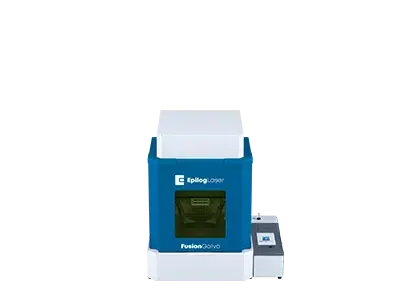
Fusion Galvo
Máquinas de marcado en metalÁrea de trabajoMáx. 6″ x 6″
(152x152mm)Tipofiber
Vataje30-100
(MOPA)Fusion Galvo es el sistema industrial de marcado metálico de Epilog que cuenta con un área de trabajo ajustable, velocidades ultrarrápidas y el potente sistema de cámara IRIS para colocar diseños de manera rápida y precisa. -
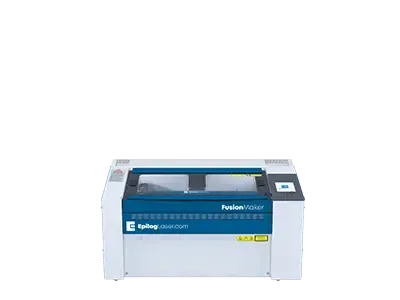
Fusion Edge 12
Serie empresarialÁrea de trabajo24″ x 12″
(610 x 305 mm)TipoCO2, fibra
VatajeCO2: 50-60
Fibra: 30Nuestro sistema láser compacto está disponible en varias configuraciones de vataje y cuenta con velocidades de grabado de hasta 120 IPS/3,05 m/s. También está disponible con una fuente de láser de fibra. -
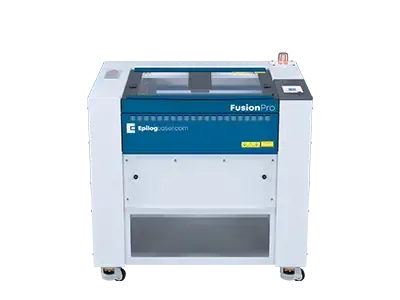
Fusion Pro 24
Serie industrialÁrea de trabajo24″ x 24″
(610 x 610 mm)TipoCO2, fibra, doble fuente
VatajeCO₂: 60-100
Fibra: 60El Pro 24, el más pequeño de nuestra serie de láseres industriales Fusion Pro, está disponible en 60, 80 o 100 vatios y se puede configurar como un sistema de doble fuente con capacidades de láser de fibra y CO2 . -
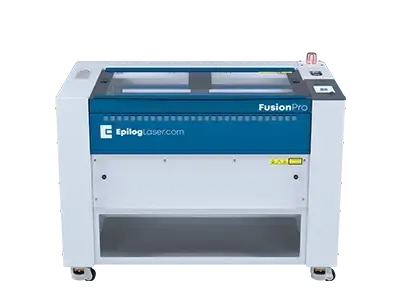
Fusion Pro 36
Serie industrialÁrea de trabajo36″ x 24″
(914 x 610 mm)TipoCO2, doble fuente
VatajeCO2: 60-200
Fibra: 30-60Como todos los sistemas de la serie de láseres Fusion Pro, el Pro 36 incluye el sistema de cámara IRIS de Epilog, junto con velocidades de grabado de hasta 165 pulgadas por segundo (4,2 m/s). -
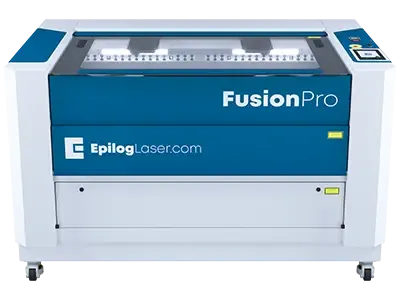
Fusion Pro 48
Serie industrialÁrea de trabajo48″ x 36″
(1219 x 914 mm)TipoCO2, doble fuente
VatajeCO2: 80-200
Fibra: 60El más grande de los Fusion Pros, este sistema industrial está disponible en configuraciones de 80, 100, 120 y 200 vatios, como un sistema de doble fuente, y se puede conectar en red a través de Ethernet incorporado, USB o de forma inalámbrica.
